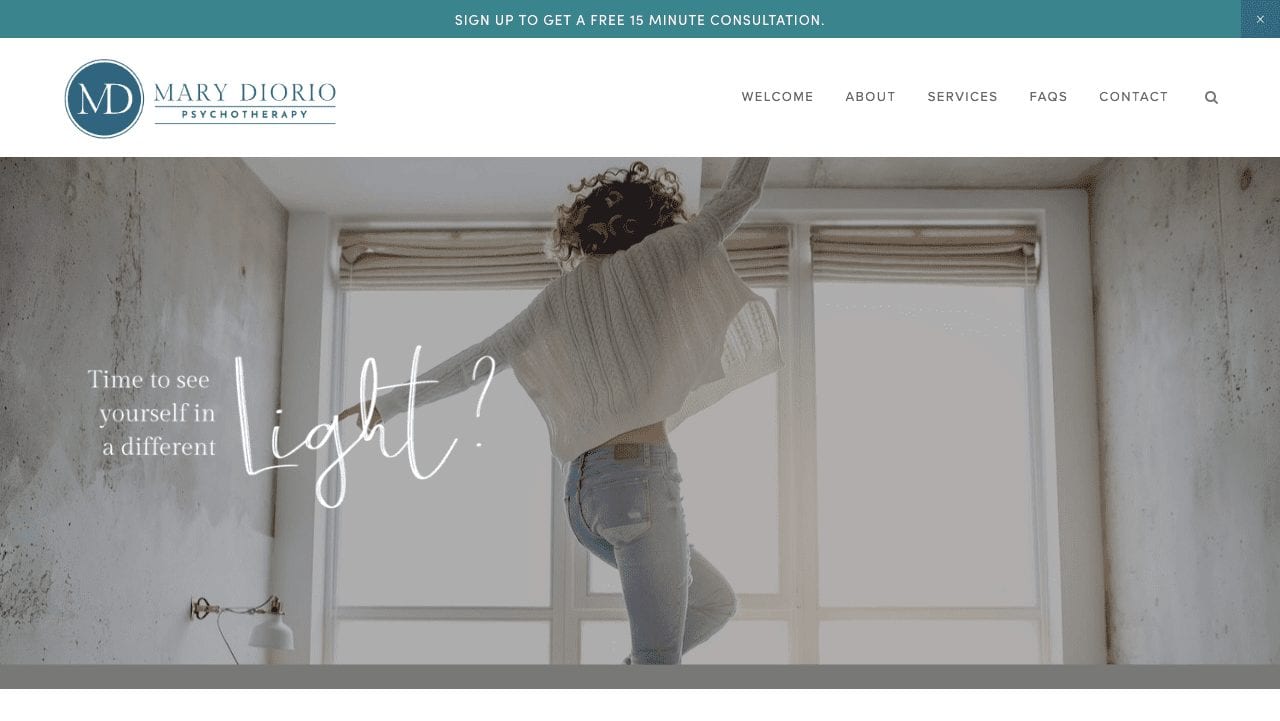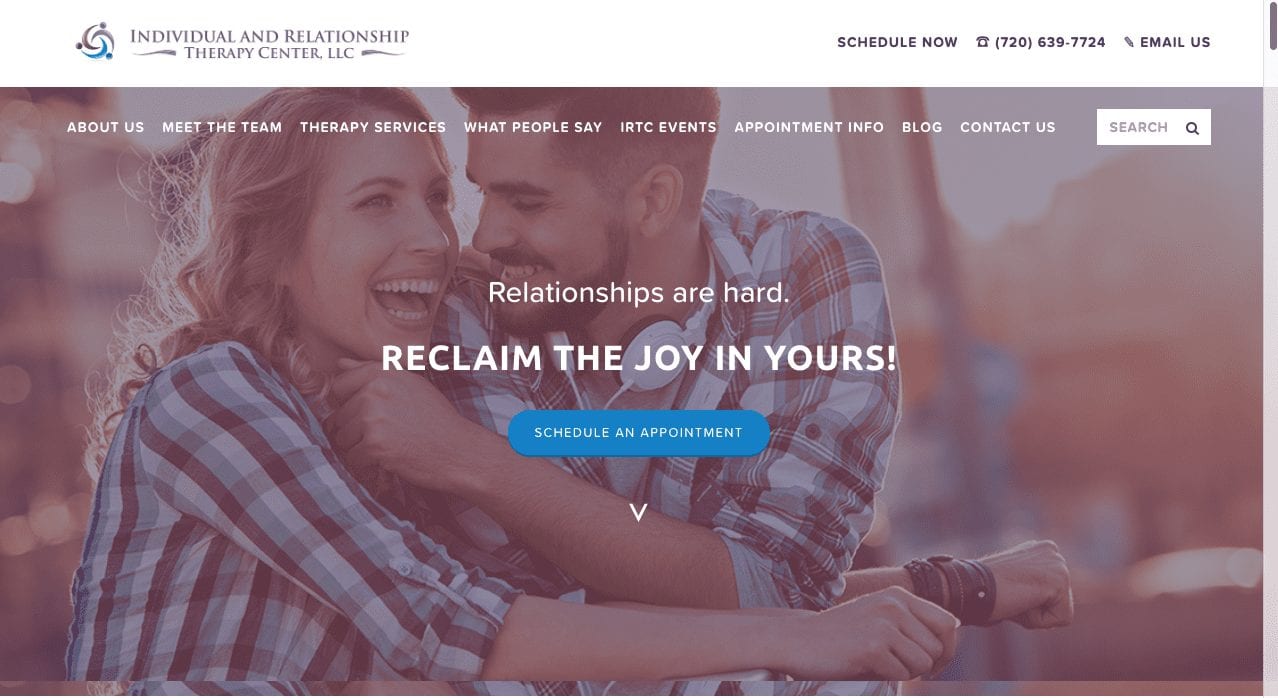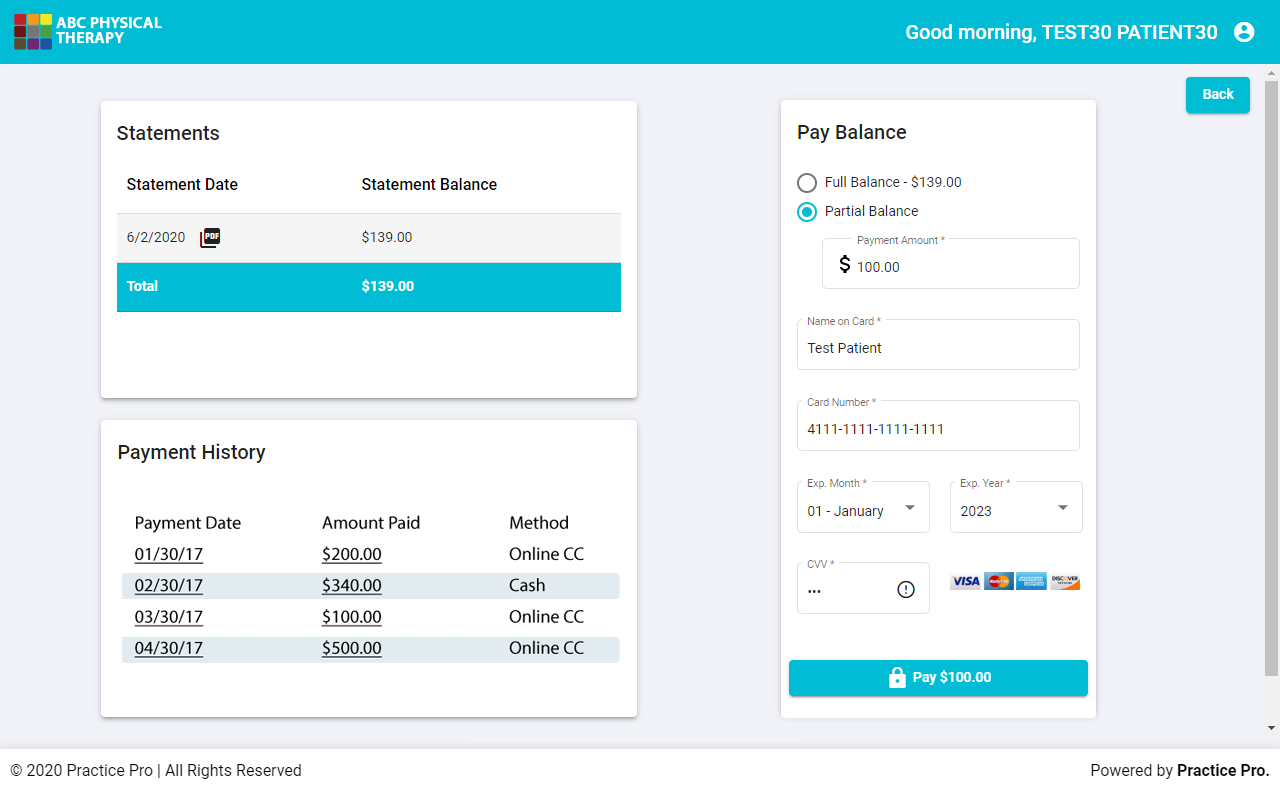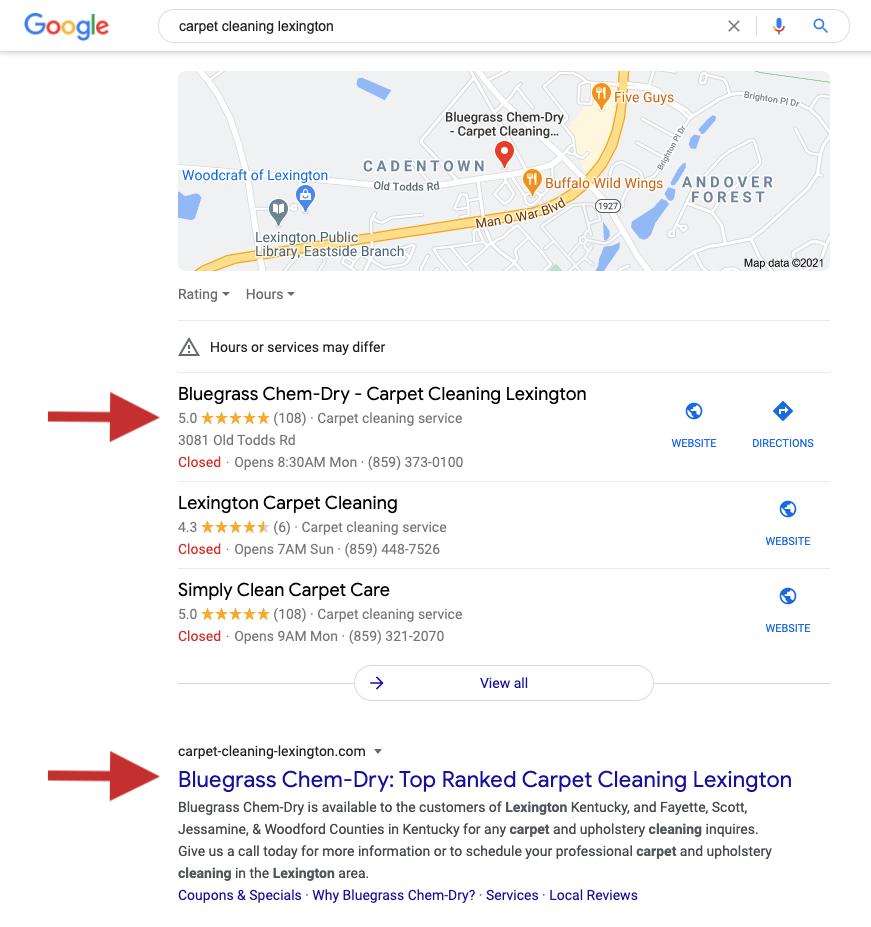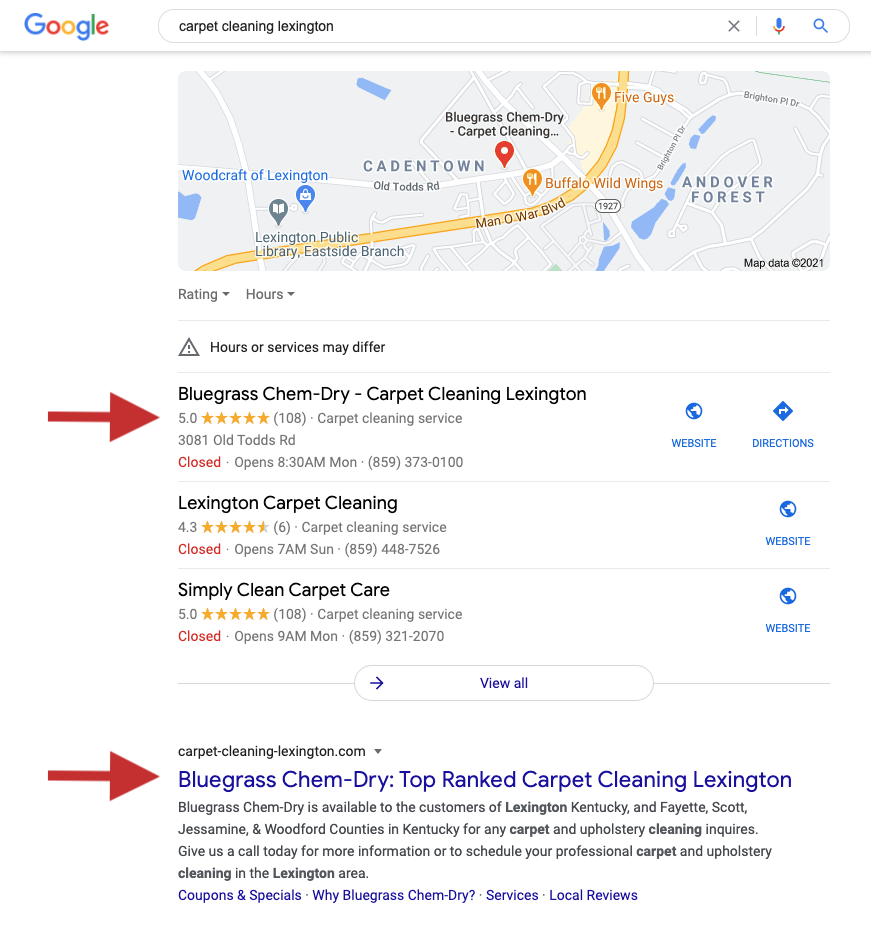Therapist web design trends are evolving at a rapid pace. In today’s digital age, the mental healthcare industry is at a turning point in client acquisition.
This is why designing a modern mental healthcare website is a fundamental step toward finding the right clients. Counselors looking to take advantage of the digital space have to adapt their website designs to make sure potential clients feel welcomed and safe.
This article is the ultimate cheat sheet for those looking to build therapist websites. It will help you create a welcoming experience that is engaging, easy to use, and meets the need of your potential patients.
 SOURCE
This is known as “session time” in the industry, and a low session time is a clear indicator of unhappy visitors.
As a mental healthcare professional, you may not think your website needs a flashy design, and you’d be right.
What your website does need is a design that helps you achieve your business goals, which is where clean web design comes into play.
Use a simple navigation menu with no more than two web-friendly fonts styles. The colors for your navigation and font should match but have a contrast ratio of at least 3:1.
Keeping color contrast high will help your calls to action stand out more, leading to more appointment requests.
The call to action should also be the only element to appear above the fold other than your header.
Lastly, to keep things uniform, the same website layout, styles, and colors should be used across your entire site.
A uniform design helps strengthen your brand and returns a large increase in perceived value.
SOURCE
This is known as “session time” in the industry, and a low session time is a clear indicator of unhappy visitors.
As a mental healthcare professional, you may not think your website needs a flashy design, and you’d be right.
What your website does need is a design that helps you achieve your business goals, which is where clean web design comes into play.
Use a simple navigation menu with no more than two web-friendly fonts styles. The colors for your navigation and font should match but have a contrast ratio of at least 3:1.
Keeping color contrast high will help your calls to action stand out more, leading to more appointment requests.
The call to action should also be the only element to appear above the fold other than your header.
Lastly, to keep things uniform, the same website layout, styles, and colors should be used across your entire site.
A uniform design helps strengthen your brand and returns a large increase in perceived value.
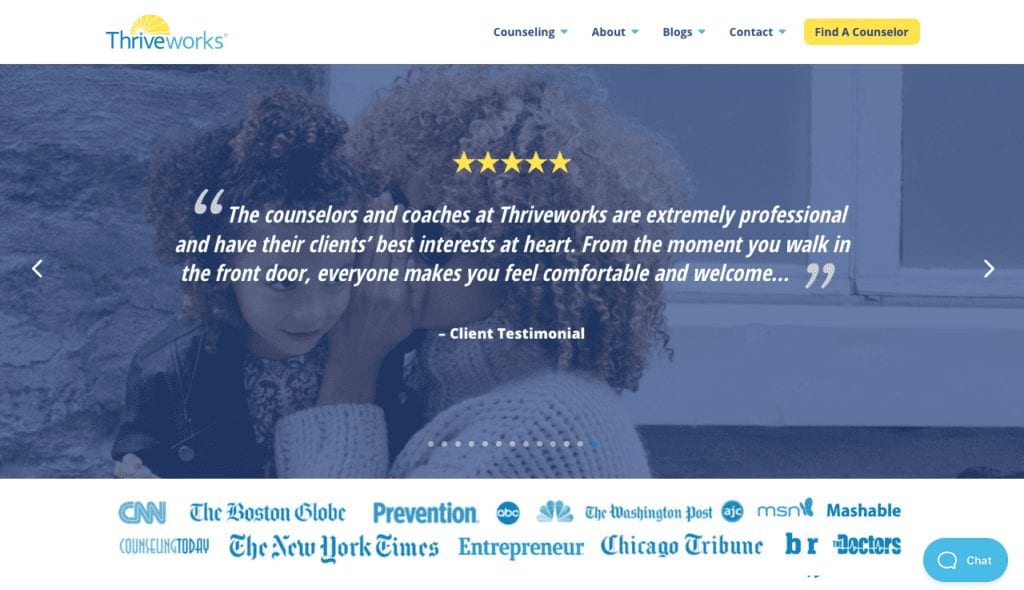 SOURCE
In the case of your private practice, clients will be more likely to schedule appointments with you if your facility receives positive reviews on a regular basis.
To be sure you’re in control of your business, you’ll need to claim your local business on online platforms. These platforms Google, Facebook, Yelp, Twitter, Instagram.
Even if you don’t plan on using the platform, you should still claim your business’s name.
If you’ve just opened your private practice, then gathering some client testimonials can help add authority to your site.
Testimonials and reviews are perfect to showcase on your homepage, team page, and your Services page. They are also prime material to use in marketing materials, such as ads and PPC campaigns.
SOURCE
In the case of your private practice, clients will be more likely to schedule appointments with you if your facility receives positive reviews on a regular basis.
To be sure you’re in control of your business, you’ll need to claim your local business on online platforms. These platforms Google, Facebook, Yelp, Twitter, Instagram.
Even if you don’t plan on using the platform, you should still claim your business’s name.
If you’ve just opened your private practice, then gathering some client testimonials can help add authority to your site.
Testimonials and reviews are perfect to showcase on your homepage, team page, and your Services page. They are also prime material to use in marketing materials, such as ads and PPC campaigns.
 Web Design for Therapists is a difficult web development niche to master but highly rewarding when you do.
The most important thing any website you create must do is offer convenience and security for clients who expect it most.
Something we didn’t cover in the article is what to do AFTER your website is set up.
After you’ve set up your proverbial lemonade stand, it’s time to start getting customers. The best way to do that is by understanding the importance of Digital Marketing for Therapists.
If this process seems too complicated, don’t worry! We’re here to help.
Book a free consultation by clicking here or write to us on our contact page.
Web Design for Therapists is a difficult web development niche to master but highly rewarding when you do.
The most important thing any website you create must do is offer convenience and security for clients who expect it most.
Something we didn’t cover in the article is what to do AFTER your website is set up.
After you’ve set up your proverbial lemonade stand, it’s time to start getting customers. The best way to do that is by understanding the importance of Digital Marketing for Therapists.
If this process seems too complicated, don’t worry! We’re here to help.
Book a free consultation by clicking here or write to us on our contact page.
What is Therapist Website Design?
Therapist web design is a specific web design strategy for developing business websites in the mental healthcare industry. Think of it as a subset of web design in which the content and functionality you apply to a website are optimized for mental healthcare. This distinction is important because while mental health businesses are businesses, they’re quite different technically from other businesses because of Google’s YMYL policy. Your customers aren’t called customers, for example, they’re “patients.” Payment is different too. The payment process is done on a monthly basis similar to SaaS, which changes our approach to customer acquisition. We’re looking for long-term clients, not one-off sales. As such, mental health practices require a different approach to web design.What Should a Counselor’s Website Include?
So, what elements does a great mental health care website need exactly? That’s what the next portion of this article is going to cover. Let’s start by going over all of the basic parts any counselor’s website should have. Here’s a quick breakdown of the parts that combine to make a great mental healthcare website:- Clean, uniform design
- Simple navigation
- HIPAA compliance
- Accessible web design
- Business information
- Therapist team profile
- Online scheduling
- Online payments
- Patient reviews and testimonials
Minimal and Uniform Website Design For Therapists
Every professional website should have a clean design regardless of industry. This is especially true for counselor websites. Clients that need professional help aren’t likely to have the patience to deal with a complicated site. Unfortunately, the mental healthcare industry is behind the times when it comes to clean sites. Far too many private practice sites clutter their homepages with a list of their services, business hours, college degrees, contact information, testimonials, and anything else they can jam in there. – all before the visitor has even had a chance to scroll.It gets worse… their outdated site layout is paired with color schemes that make the site look unprofessional, fonts that are hard too small, and navigation choices that make visitors leave and never come back.
 SOURCE
This is known as “session time” in the industry, and a low session time is a clear indicator of unhappy visitors.
As a mental healthcare professional, you may not think your website needs a flashy design, and you’d be right.
What your website does need is a design that helps you achieve your business goals, which is where clean web design comes into play.
Use a simple navigation menu with no more than two web-friendly fonts styles. The colors for your navigation and font should match but have a contrast ratio of at least 3:1.
Keeping color contrast high will help your calls to action stand out more, leading to more appointment requests.
The call to action should also be the only element to appear above the fold other than your header.
Lastly, to keep things uniform, the same website layout, styles, and colors should be used across your entire site.
A uniform design helps strengthen your brand and returns a large increase in perceived value.
SOURCE
This is known as “session time” in the industry, and a low session time is a clear indicator of unhappy visitors.
As a mental healthcare professional, you may not think your website needs a flashy design, and you’d be right.
What your website does need is a design that helps you achieve your business goals, which is where clean web design comes into play.
Use a simple navigation menu with no more than two web-friendly fonts styles. The colors for your navigation and font should match but have a contrast ratio of at least 3:1.
Keeping color contrast high will help your calls to action stand out more, leading to more appointment requests.
The call to action should also be the only element to appear above the fold other than your header.
Lastly, to keep things uniform, the same website layout, styles, and colors should be used across your entire site.
A uniform design helps strengthen your brand and returns a large increase in perceived value.
Website Navigation & Primary Links
Following the same design for your header as you do your website layout is the best way to go. Prioritize a design that helps move you toward your business goals. In the case of your navigation menu, it also helps to know what clients expect from your business. Your client’s expectations determine what pages to add to your menu. A rookie mistake you’ll want to avoid is inserting every page of your website in your main navigation menu. The secondary pages can be added to your footer instead, saving your top menu for primary pages. What is the difference between primary pages and secondary pages? Primary pages are pages customers expect to find on your site AND also help your business goals. A blog, for example, might be a link that’s added to your footer rather than the primary navigation. Let’s brainstorm some primary pages. Visitors expect to be able to easily find some, if not all, of the following information on your site:- Services you offer
- Details on providers
- Location and contact details
- What to expect during their visit
- Online scheduling
- Online payments
- Billing and insurances you accept
HIPAA Compliant Mental Health Web Designs
While most people think of doctors when they hear HIPAA, it applies to all healthcare professionals – including therapists. HIPAA is the Health Insurance Portability and Accountability Act of 1996. It’s designed to secure protected health information (PHI) by enforcing a set of laws and regulations on healthcare organizations that transfer PHI electronically. PHI includes patient names, email addresses, addresses, social security numbers, phone numbers, medical records, financial details, and even images that show a patient’s face in full. HIPAA compliance comes in two forms as it relates to mental health website designs.- Ensuring the systems you implement to process data are HIPAA compliant.
- Showing the HIPAA seal of approval across your site, usually by placing it in your footer.
- Voluntarily comply with the HIPAA Rules
- Take corrective action
- Agree to a settlement
How To Address Accessible Web Design
Accessibility in web design for therapists is defined as the ease with which disabled visitors are able to navigate your website. Impaired eyesight, for example, is a significant concern when designing an accessible website. Not only does accessible web design lead provide a better experience for those with impairments, but it also ensures your website is compliant with the Americans with Disabilities Act (ADA). There are many ways you can make your therapist’s website design more accessible, here are a few:- Ensure all links on your page are accessible by tapping the Tab key alone.
- Make entire buttons and their paddings clickable
- Use descriptive labels in forms.
- Avoid using pop-ups
- Add descriptive alt text to images.
- Only choose third-party applications with accessible designs.
Online Scheduling for Mental Healthcare Sites
As we mentioned earlier in the article, potential clients expect to do quite a bit on your website, including schedule appointments. This means your counseling website should include online appointment scheduling. It’ll make the patient experience much more convenient for your clients while also making the visitor-to-client conversion easier. To ensure you receive the highest chances of success with this strategy, do not require visitors to create an account in order to schedule an appointment. Upwards of 86% of visitors click away when they need to make an account to perform an action. The best-case scenario is that they are able to schedule the appointment by selecting a date and time from your website. Not only does this create a high-quality user experience, but it also helps save on receptionist duties. While it’s the easier option, we recommend against creating a simple web form your patient can use to request an appointment. How do you add this level of scheduling to your mental health site? That’s a functionality a web developer can create and fine tune for you. Lastly, don’t forget to include a call to action to use in the hero section of your homepage. The hero section is the most effective spot on your site to place a CTA.Online Bill Pay for Health Insurance
Scheduling appointments isn’t the only thing mental health clients expect to be more convenient. They also prefer the option to pay their session bills without making a drive or mailing checks. The best way to serve your clients in this regard is to have a way for them to pay medical bills online. The mental healthcare industry takes a different approach to billing than the average industry does. Not only does the payment system need to be HIPAA compliant, but you’ll likely need a way to set up recurring payments. Recurring payments should only go through if a client’s session was completed, not just scheduled. The usual way to add this functionality to your web design is through an online billing portal. The paying portal should absolutely have its own dedicated page and should be included in the main navigation menu. No need to get fancy, simply title this page “Billing and Insurance Information” and keep moving. This page should explain how the billing process works, what insurance you accept, how patients can pay for their medical bills, and if you offer payment plans. As for how to accept payments, private practices have a number of ways to accept payments online and create customized billing plans for customers. We recommend browsing this list of the 10 best online payment services to find one that perfectly fits your practice.Core Business Information
Your private practice is still a business at the end of the day, so your site should include the same contact information every business needs. This information includes your business hours, contact options, and physical address for your practice. It’s best to add this information in your header as well as your footer. Your dedicated “Contact” page should have all of this information as well. Although the main star of your Contact page should be a contact form that potential clients can fill out.Therapist Profile – “About Me” Page
“About Me” pages are a way for potential patients to get to know you so they can make determine if you’re the kind of mental healthcare provider they’d like to make an appointment with. Not unlike dating profiles, adding high-quality images to your About Me page is one of the best ways to add a layer of professionalism. It’s another factor in helping patients feel confident enough to schedule an appointment. We HIGHLY recommend adding a video to your About Me page. It can replace a picture or be an addition… it has a massive ROI either way. The video itself may only take a few minutes to record, but it’s the best way for visitors to get a feel for who you are as a person and if you are the right therapist for them. If your practice involves multiple counselors, you can choose to include them all on the About Me page or have a separate page for them. The easiest way to decide which to do is by counting your therapists. Have more than 3? Separate page. The separate Team page can include a collection of smaller profiles for other members of your staff patients may encounter during their visit, too, including receptionists and other workers. Just like the About Page, you should include an image, their name, and title at the very least. Adding more information is always better if you have the time and resources for it.Patient Reviews and Testimonials
Pulling in a review system to your site and showcasing reviews patients leave for you is one of the most effective marketing strategies you can include in your Counselor’s website design.It takes advantage of something called social proof, which essentially says that we’re more likely to do something based on the actions of others. You’re more likely to go to a food truck with 5 stars on Google than a truck with 2 stars.
 SOURCE
In the case of your private practice, clients will be more likely to schedule appointments with you if your facility receives positive reviews on a regular basis.
To be sure you’re in control of your business, you’ll need to claim your local business on online platforms. These platforms Google, Facebook, Yelp, Twitter, Instagram.
Even if you don’t plan on using the platform, you should still claim your business’s name.
If you’ve just opened your private practice, then gathering some client testimonials can help add authority to your site.
Testimonials and reviews are perfect to showcase on your homepage, team page, and your Services page. They are also prime material to use in marketing materials, such as ads and PPC campaigns.
SOURCE
In the case of your private practice, clients will be more likely to schedule appointments with you if your facility receives positive reviews on a regular basis.
To be sure you’re in control of your business, you’ll need to claim your local business on online platforms. These platforms Google, Facebook, Yelp, Twitter, Instagram.
Even if you don’t plan on using the platform, you should still claim your business’s name.
If you’ve just opened your private practice, then gathering some client testimonials can help add authority to your site.
Testimonials and reviews are perfect to showcase on your homepage, team page, and your Services page. They are also prime material to use in marketing materials, such as ads and PPC campaigns.
Finish Strong
 Web Design for Therapists is a difficult web development niche to master but highly rewarding when you do.
The most important thing any website you create must do is offer convenience and security for clients who expect it most.
Something we didn’t cover in the article is what to do AFTER your website is set up.
After you’ve set up your proverbial lemonade stand, it’s time to start getting customers. The best way to do that is by understanding the importance of Digital Marketing for Therapists.
If this process seems too complicated, don’t worry! We’re here to help.
Book a free consultation by clicking here or write to us on our contact page.
Web Design for Therapists is a difficult web development niche to master but highly rewarding when you do.
The most important thing any website you create must do is offer convenience and security for clients who expect it most.
Something we didn’t cover in the article is what to do AFTER your website is set up.
After you’ve set up your proverbial lemonade stand, it’s time to start getting customers. The best way to do that is by understanding the importance of Digital Marketing for Therapists.
If this process seems too complicated, don’t worry! We’re here to help.
Book a free consultation by clicking here or write to us on our contact page.

